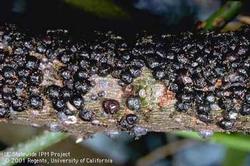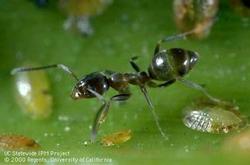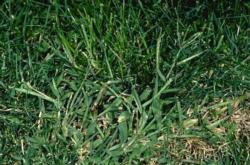
January
Citrus Scale Insects
There are small dark bumps on the twigs and branches of my citrus. Or, there is white, fluffy stuff on the twigs and leaves. The leaves are turning yellow and falling off and twigs are dying back. Why?
Answer: The small dark bumps are citrus scale (probably brown soft scale) and the white fluffy stuff is cottony cushion scale. Both are common pests on citrus. To eradicate both of these pests, spray horticultural (not dormant) oil twice, in May and June, two weeks apart when temperatures are not above 90 degrees. This should smother and kill the young scale in the crawler stage. You can also spray during the cooler season when temps are not under 32 degrees. Thoroughly drench all surfaces of the tree as well as the soil underneath. Always read the labels and follow directions carefully. When improperly applied, horticultural oils can damage trees.


Ants and Scale Insects
There are ants in my citrus and sticky stuff on the leaves and fruit and black stuff on the fruit itself. What is this?

Answer: The ants are feeding on the honeydew (the sticky stuff) excerted by the scale and are herding the scale and driving off beneficial insects that would prey on them. The black stuff is sooty mold instigated by the presence of the honeydew. To help control scale, you must control the ants. Use a sticky barrier product like Tanglefoot ™ or Stickum ™ to trap the ants. Follow the directions carefully. You can also use a boric acid bait or an ant bait. Diazinon is no longer recommended because traces are showing up in the ground water. Spraying with insecticides is not recommended since it kills off the beneficial insects such as lady bugs and parasitic wasps which pray on the scale. Scale populations tend to increase dramatically after pesticide use. Sooty mold can be washed off the fruit. The fruit is still edible.
Citrus Pest Notes: Ants on Citrus Black Scale on Citrus Cottony Scale
Red & Yellow Scale
Lawns
Q. What is the best time to apply pre-emergent on my lawn to prevent crabgrass?
A. The Fresno Bee, January 17, 2002 Crabgrass can be easily and safely controlled using a pre-emergent herbicide, but timing is everything. The key is to apply the products before the weeds germinate in the latter part of January and early February, depending on the weather that year. Look for products containing one of the following active ingredients; benefin, bensulide, DCPA, dithiopyr, orayzalin, pendimethalin, prodiamine and trifluralin. Follow directions carefully. Depending on the weather, seeds may continue to germinate throughout the spring and summer. Proper irrigation and adequate fertilization will aid in preventing crabgrass because a lawn is more competetive and can shade out weeds. Fertilize the lawn once it begins active growth in the spring. For tall fescue apply during February. For Bermuda grasses, apply a pre-emergent late March to early April.
Note: Spotted spurge seeds will also germinate in February in our warm climate. Pre-emergents that will control both crabgrass and spurge are available. They are: (1) DCPA, (2) dithipyr, (3) oryzalin, and (4) pendimethalin. Remember that pre-emergents prevent all seeds from germinating for 6 weeks and apply carefully near flower and vegetable beds.
Lawn Pest Notes: Weed Management in Lawns

